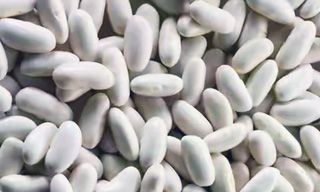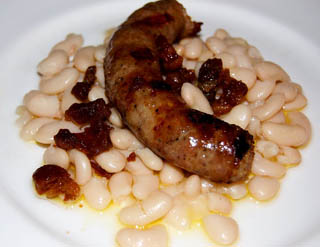Cannellini beans Nutrition facts
Cannellini beans, also known as Italian white kidney beans, belong to common bean (Phaseolus vulgaris) cultivars in the Fabaceae family of legumes. They are integral to the classic Mediterranean dishes, particularly Italian cuisine.
Binomial name: Phaseolus vulgaris. Genus: Vigna. Cannellini beans are also known as abulia beans, ingot beans, cannelloni, white coco, etc.
 |
| Dry cannellini beans. |
Cannellini is a dwarf bush-type bean (dicotyledonous) plant. It flourishes in well-draining loam soil, supplemented with adequate moisture and humus.
It is a short-duration crop and takes 75-90 days from seedling to harvest.
Pods appear in bunches, with each holding about 4-8 plump, creamy-white seeds. Cannellini beans are slightly larger and flatter than haricot beans and surrounded by a thin white seed coat. Boiled cannellini features a fine nutty flavor and pleasant beany taste.
Health Benefits of Cannellini Beans
Cannellini beans are a rich source of easily digestible bean starch, high-quality protein, fiber, essential minerals, and vitamins that support overall health and nutrition.
These cholesterol-free and low-fat legumes are beneficial for heart health. Dry cannellini beans provide about 333 calories and 23.36 g of protein per 100 g, contributing to 41% of the recommended daily allowance.
Cannellini beans contain small amounts of beneficial compounds such as isoflavones and pro-anthocyanidin dimers. Dietary isoflavones are known to help reduce the risk of post-menopausal cancer and osteoporosis in women.
The seed coat of cannellini beans is a valuable source of dietary fiber and calcium among white beans. Fiber acts as a natural bulk laxative, protecting the colon mucosa by binding and eliminating cancer-causing toxins from the body.
Dietary fiber in cannellini beans also helps lower blood cholesterol levels by reducing the reabsorption of bile acids in the colon.
Cannellini beans are naturally gluten-free, making them an ideal protein-rich food for individuals with gluten allergy or celiac disease.
They are excellent sources of several B-complex vitamins including folates, pyridoxine, thiamin (vitamin B1), pantothenic acid, riboflavin, and niacin. These vitamins act as co-factors for enzymes involved in carbohydrate, protein, and fat metabolism.
Dry cannellini beans provide 388 μg of folates (97% DV). Folate, along with vitamin B-12, is crucial for DNA synthesis and cell division. Adequate folate intake before and during pregnancy helps prevent neural tube defects in newborns.
Cannellini beans are a mineral-rich food. 100 g of dry beans contain calcium (24%), iron (130%), manganese (78%), phosphorus (43%), and zinc (33%), all essential for maintaining good health.
Additionally, 100 g of cannellini beans deliver about 1795 mg (38%) potassium—a vital electrolyte that helps balance sodium levels and supports healthy heart function and blood pressure.
The U.S. Dietary Guidelines for Americans recommend consuming about 3 cups of legumes, including beans, every week. To meet this dietary guideline, aim for at least half a cup of beans daily as part of a balanced diet.
```| Principle | Nutrient Value | Percent of RDA |
|---|---|---|
| Energy | 333 Kcal | 16.65% |
| Carbohydrates | 60.27 g | 46% |
| Protein | 23.36 g | 41.7% |
| Total Fat | 0.85 g | 4% |
| Cholesterol | 0 mg | 0% |
| Dietary Fiber | 15.2 g | 40% |
| Vitamins | ||
| Folates | 388 μg | 97% |
| Niacin | 0.479 mg | 3% |
| Pantothenic acid | 0.732 mg | 14.6% |
| Pyridoxine | 0.318 mg | 24% |
| Riboflavin | 0.146 mg | 11% |
| Thiamin | 0.437 mg | 36% |
| Vitamin-C | 0 mg | - | Electrolytes |
| Sodium | 16 mg | 1% |
| Potassium | 1795 mg | 38% |
| Minerals | ||
| Calcium | 240 mg | 24% |
| Iron | 10.44 mg | 130.5% |
| Magnesium | 190 mg | 47.5% |
| Manganese | 1.796 mg | 78% |
| Phosphorus | 0.301 mg | 43% |
| Selenium | 12.8 μg | 23% |
| Zinc | 3.67 mg | 33% |
Selection and storage
In the U.S. and Canada, dried, cooked, and canned cannellini beans packed in water or oil are widely available both online and in supermarkets.
During the harvest season, fresh shelled beans can also be found at local farmers' markets.
When buying dry beans, choose cream-white, smooth beans that are organically produced for better freshness, flavor, and texture. For convenience, cooked or canned beans can also be used in quick recipes.
Avoid beans with splits, surface cracks, or cuts, as these may not cook evenly or hold their shape well.
Store dry beans in a cool, dark place inside an airtight container, away from heat and humidity to preserve quality.
Preparation and Serving Methods
Cannellini beans are among the most popular varieties in North America and Europe, valued for their nutritional benefits and creamy texture. Once cooked, they have a mild nutty flavor and stay firm and whole.
Before cooking, dry beans should be soaked for at least 5 hours in cold water. Use a wide pan while boiling to remove the foam, which helps eliminate gas-forming compounds.
Here are some serving tips:
 |
| Sausage and cannellini beans. Photo courtesy: Ryan Godfrey |
Cannellini beans are a staple in traditional Tuscan cuisine, where they are used in flavorful dips, soups, and stews combined with aromatic herbs, spices, and vegetables.
Boiled cannellini beans pair beautifully with chopped tomato, parsley, and onion, then seasoned with lemon juice and olive oil to make a refreshing bean salad.
The beans are an essential ingredient in tonno e fagioli — the classic tuna and bean salad enjoyed across Italy.
Prepare traditional pasta e fagioli using cannellini beans and a small type of pasta such as elbow macaroni or ditalini for an authentic Italian meal.
Generally, cannellini beans are boiled and used in various dishes, mashed into dips, or served with chunks of fresh or toasted bread.
Safety Profile
Consumption of raw or soaked cannellini beans is not advisable as it can be harmful to health. They contain phyto-hemagglutinin (lectin) toxin, which may cause red blood cell clumping and symptoms such as nausea, vomiting, and diarrhea.
Proper cooking, especially in a pressure cooker, destroys the toxins and makes the beans completely safe to eat. (Medical disclaimer).
You may also like to read≻≻-
Adzuki beans nutrition facts and health benefits.
Chickpeas nutrition facts and health benefits.
Lima beans nutrition facts and health benefits.
fava beans nutrition facts and health benefits.
≻≻-Back to Legumes from Cannellini beans. Visit here for an impressive list of vegetables with complete illustrations of their nutrition facts and health benefits.
≻≻-Back to Home page.
Further Resources: